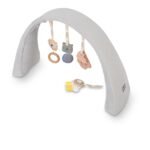Wie wird Anämie bei Kindern diagnostiziert?

Wie wird Anämie bei Kindern diagnostiziert?
Eisenmangelanämie kann durch eine Vielzahl von Faktoren verursacht werden, z. B:
- Eisenarme Ernährung: Ein Kind nimmt Eisen mit der Nahrung auf, aber nur eine geringe Menge wird tatsächlich vom Körper aufgenommen. Neugeborene, die von gesunden Müttern geboren werden, speichern in den letzten drei Monaten der Schwangerschaft Eisen. Säuglinge von Müttern mit Anämie oder anderen Gesundheitsproblemen können jedoch nicht genug Eisen speichern, und Frühgeborene haben besonders niedrige Eisenspeicher.
- Veränderungen im Körper: In Zeiten schnellen Wachstums benötigt der Körper mehr Eisen, um neue rote Blutkörperchen zu bilden. Babys im Alter zwischen 4 und 6 Monaten beginnen, die während der Schwangerschaft angelegten Eisenspeicher aufzubrauchen, so dass in dieser Zeit die Gefahr eines Mangels besteht.
- Probleme mit dem Verdauungssystem: Nach bestimmten Operationen des Verdauungssystems oder aufgrund von Krankheiten, die die Darmfunktion beeinträchtigen, kann eine Eisenmalabsorption auftreten. Das meiste Eisen wird im oberen Teil des Dünndarms absorbiert, und jede Störung dieses Prozesses kann zu Anämie führen.
Zu den häufigsten Symptomen einer Anämie bei Kindern gehören:
- Blasse Haut,
- Reizbarkeit und Nervosität,
- Müdigkeit oder Energielosigkeit,
- Erhöhte Herzfrequenz,
- Schmerzen oder Anschwellen der Zunge,
- Vergrößerte Milz,
- Verlangen, ungewöhnliche Dinge wie Schmutz oder Eis zu essen.
Die American Academy of Pediatrics (AAP) empfiehlt ein Anämie-Screening mit einem Hämoglobin-Test für alle Säuglinge ab einem Alter von 12 Monaten. Der Test sollte auch eine Risikobewertung umfassen, bei der Fragen zu Ernährungsproblemen, Wachstumsverzögerungen und anderen spezifischen Gesundheitsbedürfnissen gestellt werden. Wenn Ihr Hämoglobinwert niedrig ist, werden weitere Bluttests durchgeführt, z. B:
- Hämoglobin- und Hämatokritwerte: Hierbei handelt es sich um einen grundlegenden Screening-Test, der die Menge an Hämoglobin und roten Blutkörperchen in Ihrem Blut misst.
- Vollständiges Blutbild (CBC): Hierbei handelt es sich um einen detaillierteren Test, bei dem die Anzahl der roten und weißen Blutkörperchen, der Blutplättchen und der jungen roten Blutkörperchen (Retikulozyten) untersucht wird. Das vollständige Blutbild umfasst auch Hämoglobin und Hämatokrit sowie detaillierte Informationen über die roten Blutkörperchen.
- Peripherer Blutausstrich: Eine kleine Blutprobe wird unter dem Mikroskop untersucht, um die Form und das Aussehen der Blutzellen zu beurteilen.
- Eisenspiegeltests: Mit speziellen Tests wird der Eisengehalt im Körper des Kindes gemessen.
Die frühzeitige Erkennung und angemessene Behandlung von Eisenmangel kann schwerwiegendere gesundheitliche Komplikationen verhindern.
Ferritin: Was halten wir für normal?
Die Forschung in pädiatrischen Schlafkliniken konzentriert sich zunehmend auf die Messung des Ferritinspiegels im Serum von Kindern mit Schlafstörungen wie dem Restless-Legs-Syndrom (RLS), periodischen Bewegungen der Gliedmaßen im Schlaf (PLMD) oder bei Kindern, die über unruhigen Schlaf berichten. Es stellt sich jedoch immer noch die Frage, welcher Ferritinwert bei Kindern als "normal" angesehen werden kann.
Eine von Dr. Rosen und Kollegen verfasste Studie untersuchte die Auswirkungen einer Eisensupplementierung bei Kindern mit RLS und Ferritinwerten unter 50 ng/ml, was als biochemischer Indikator für Eisenmangel definiert wurde. Die Ergebnisse zeigten, dass die Supplementierung den Ferritinspiegel erhöhte und die Schwere der RLS-Symptome verringerte, aber es gab keine direkte Korrelation zwischen den Veränderungen des Ferritinspiegels und der klinischen Verbesserung.
Ferritinspiegel bei Kindern
Studien aus pädiatrischen Schlafkliniken zeigen, dass Ferritin als Indikator für die Eisenspeicher bei Kindern mit RLS, PLMD und unruhigem Schlaf routinemäßig gemessen wird. Die Forscher untersuchen auch Kinder, die die Kriterien für RLS oder PLMD nicht erfüllen, aber über Symptome von unruhigem Schlaf und die Folgen der Störung am Tag berichten. In einer unveröffentlichten Studie wurden Daten über den Ferritinspiegel bei Kindern erhoben, die sich Schlafstudien unterzogen (ausgenommen Kinder mit Schlafapnoe). Die Ergebnisse zeigen, dass die durchschnittlichen Ferritinwerte im Serum wie folgt waren:
- 24,7 ng/ml (für Kinder im Alter von 1-5 Jahren),
- 31,4 ng/ml (für Kinder im Alter von 6-11 Jahren),
- 35,0 ng/ml (für Kinder im Alter von 12-19 Jahren).
Diese Werte liegen sehr nahe an den Ferritinwerten, die in der Allgemeinbevölkerung von Kindern in den Vereinigten Staaten ermittelt wurden, was darauf hindeutet, dass die meisten Kinder in diese Kategorie fallen würden, wenn Werte unter 50 ng/ml als Eisenmangel angesehen würden.
Ferritin und klinische Symptome
Obwohl die meisten Studien darauf hindeuten, dass bei Kindern mit RLS, PLMD und unruhigem Schlaf nach einer Eisensupplementierung eine Besserung eintritt, korrelieren die Serumferritinwerte nicht immer direkt mit der Verbesserung der Symptome. Eine mögliche Erklärung ist, dass das Serumferritin die Eisenspeicher im Gehirn nicht genau widerspiegelt, die für die Entwicklung dieser Störungen entscheidend sein können. Studien an Erwachsenen mit RLS ergaben, dass die Unterschiede in den Ferritinwerten im Liquor signifikant waren, während die Ferritinwerte im Serum bei Menschen mit und ohne RLS ähnlich blieben.
Gesunder Schlaf ist die Grundlage für das Wohlbefinden Ihres Kleinkindes, daher lohnt sich der Griff zu unserem Schläfchen-Decken und kissendie jede Nacht für Weichheit und Komfort sorgen. Für Säuglinge, Tragetaschenlaken ist ebenfalls eine ideale Lösung für einen ruhigen und sicheren Schlaf von den ersten Momenten des Lebens an.
Zum Verständnis des Ferritinspiegels
Ein wichtiger Aspekt bei der Interpretation der Ferritinwerte ist die Art und Weise, wie sie den Eltern mitgeteilt werden. Die Beschreibung von Ferritinwerten zwischen 20-30 ng/ml als "niedrig" oder als Hinweis auf "Eisenmangel" kann zu unnötigen Sorgen um die Gesundheit des Kindes führen. Stattdessen wird vorgeschlagen, solche Werte im Zusammenhang mit Schlafstörungen als "suboptimal" zu bezeichnen, ohne auf einen vollständigen Eisenmangel hinzuweisen.
Emilia Adamczyk

 Verstellbarer Spielbogen
Verstellbarer Spielbogen Verstellbarer Spielbogen mit Soundmodul
Verstellbarer Spielbogen mit Soundmodul Modulares 2-in-1-Babynest mit abnehmbaren Seitenwänden
Modulares 2-in-1-Babynest mit abnehmbaren Seitenwänden Modulares 3-in-1-Babynest mit Spielbogen
Modulares 3-in-1-Babynest mit Spielbogen Modulares 3-in-1-Babynest mit Geräuschen
Modulares 3-in-1-Babynest mit Geräuschen Modulares 4-in-1-Babynest
Modulares 4-in-1-Babynest Grow Up Schlafsack
Grow Up Schlafsack New Born Schlafsack
New Born Schlafsack Musselin-Schlafsack
Musselin-Schlafsack Schlafsäcke mit Beinen
Schlafsäcke mit Beinen Schlafsack mit abnehmbaren Ärmeln
Schlafsack mit abnehmbaren Ärmeln New Born Wickeltücher
New Born Wickeltücher Zweiter Schritt Swaddle
Zweiter Schritt Swaddle Swaddle Wraps
Swaddle Wraps Anti-Schweiß-Autositz / Tragetuchauflage 0+
Anti-Schweiß-Autositz / Tragetuchauflage 0+ Sitzauflagen & Einlagen für Kinderwagen
Sitzauflagen & Einlagen für Kinderwagen Bezüge für Babyschalen aus Musselin
Bezüge für Babyschalen aus Musselin Winter Auto Sitz Swaddle/Decke
Winter Auto Sitz Swaddle/Decke Schmetterlingskissen für Babys - Anti-Schock-Kissen
Schmetterlingskissen für Babys - Anti-Schock-Kissen Babydorm Kissen
Babydorm Kissen Teddy Kuschelkissen aus Musselin
Teddy Kuschelkissen aus Musselin Baby Bambusdecke
Baby Bambusdecke Ultraweiche Bambus-Decke
Ultraweiche Bambus-Decke Bettlaken
Bettlaken Wiegenblatt
Wiegenblatt Spielmatte
Spielmatte Tragbare Wickelauflage
Tragbare Wickelauflage Anti-Schweiß-Tragetasche/Gondelpolster
Anti-Schweiß-Tragetasche/Gondelpolster Modularer Stoßfänger für Babybetten
Modularer Stoßfänger für Babybetten Maskottchen
Maskottchen New Born Schlafsack
New Born Schlafsack Schlafsack mit abnehmbaren Ärmeln
Schlafsack mit abnehmbaren Ärmeln Swaddle Wraps
Swaddle Wraps Modularer Stoßfänger für Babybetten
Modularer Stoßfänger für Babybetten